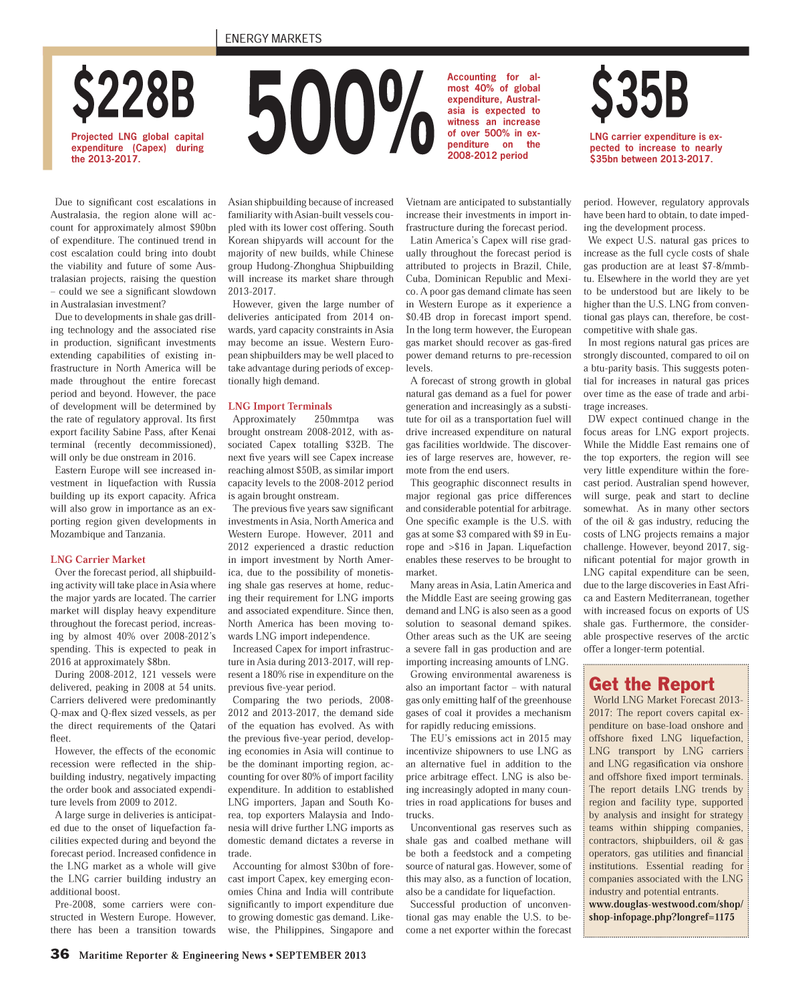
Page 36: of Maritime Reporter Magazine (September 2013)
Workboat Annual
Read this page in Pdf, Flash or Html5 edition of September 2013 Maritime Reporter Magazine
36 Maritime Reporter & Engineering News ? SEPTEMBER 2013 Due to signiÞ cant cost escalations in Australasia, the region alone will ac-count for approximately almost $90bn of expenditure. The continued trend in cost escalation could bring into doubt the viability and future of some Aus- tralasian projects, raising the question ? could we see a signiÞ cant slowdown in Australasian investment? Due to developments in shale gas drill-ing technology and the associated rise in production, signiÞ cant investments extending capabilities of existing in-frastructure in North America will be made throughout the entire forecast period and beyond. However, the pace of development will be determined by the rate of regulatory approval. Its Þ rst export facility Sabine Pass, after Kenai terminal (recently decommissioned), will only be due onstream in 2016.Eastern Europe will see increased in-vestment in liquefaction with Russia building up its export capacity. Africa will also grow in importance as an ex-porting region given developments in Mozambique and Tanzania. LNG Carrier Market Over the forecast period, all shipbuild-ing activity will take place in Asia where the major yards are located. The carrier market will display heavy expenditure throughout the forecast period, increas-ing by almost 40% over 2008-2012?s spending. This is expected to peak in 2016 at approximately $8bn.During 2008-2012, 121 vessels were delivered, peaking in 2008 at 54 units. Carriers delivered were predominantly Q-max and Q-ß ex sized vessels, as per the direct requirements of the Qatari ß eet. However, the effects of the economic recession were reß ected in the ship- building industry, negatively impacting the order book and associated expendi-ture levels from 2009 to 2012. A large surge in deliveries is anticipat- ed due to the onset of liquefaction fa-cilities expected during and beyond the forecast period. Increased conÞ dence in the LNG market as a whole will give the LNG carrier building industry an additional boost. Pre-2008, some carriers were con-structed in Western Europe. However, there has been a transition towards Asian shipbuilding because of increased familiarity with Asian-built vessels cou- pled with its lower cost offering. South Korean shipyards will account for the majority of new builds, while Chinese group Hudong-Zhonghua Shipbuilding will increase its market share through 2013-2017.However, given the large number of deliveries anticipated from 2014 on-wards, yard capacity constraints in Asia may become an issue. Western Euro- pean shipbuilders may be well placed to take advantage during periods of excep-tionally high demand. LNG Import Terminals Approximately 250mmtpa was brought onstream 2008-2012, with as-sociated Capex totalling $32B. The next Þ ve years will see Capex increase reaching almost $50B, as similar import capacity levels to the 2008-2012 period is again brought onstream. The previous Þ ve years saw signi Þ cant investments in Asia, North America and Western Europe. However, 2011 and 2012 experienced a drastic reduction in import investment by North Amer- ica, due to the possibility of monetis-ing shale gas reserves at home, reduc-ing their requirement for LNG imports and associated expenditure. Since then, North America has been moving to- wards LNG import independence.Increased Capex for import infrastruc-ture in Asia during 2013-2017, will rep- resent a 180% rise in expenditure on the previous Þ ve-year period. Comparing the two periods, 2008-2012 and 2013-2017, the demand side of the equation has evolved. As with the previous Þ ve-year period, develop- ing economies in Asia will continue to be the dominant importing region, ac-counting for over 80% of import facility expenditure. In addition to established LNG importers, Japan and South Ko-rea, top exporters Malaysia and Indo-nesia will drive further LNG imports as domestic demand dictates a reverse in trade. Accounting for almost $30bn of fore-cast import Capex, key emerging econ- omies China and India will contribute signiÞ cantly to import expenditure due to growing domestic gas demand. Like-wise, the Philippines, Singapore and Vietnam are anticipated to substantially increase their investments in import in-frastructure during the forecast period.Latin America?s Capex will rise grad- ually throughout the forecast period is attributed to projects in Brazil, Chile, Cuba, Dominican Republic and Mexi-co. A poor gas demand climate has seen in Western Europe as it experience a $0.4B drop in forecast import spend. In the long term however, the European gas market should recover as gas-Þ red power demand returns to pre-recession levels.A forecast of strong growth in global natural gas demand as a fuel for power generation and increasingly as a substi-tute for oil as a transportation fuel will drive increased expenditure on natural gas facilities worldwide. The discover- ies of large reserves are, however, re- mote from the end users.This geographic disconnect results in major regional gas price differences and considerable potential for arbitrage. One speciÞ c example is the U.S. with gas at some $3 compared with $9 in Eu-rope and >$16 in Japan. Liquefaction enables these reserves to be brought to market. Many areas in Asia, Latin America and the Middle East are seeing growing gas demand and LNG is also seen as a good solution to seasonal demand spikes. Other areas such as the UK are seeing a severe fall in gas production and are importing increasing amounts of LNG.Growing environmental awareness is also an important factor ? with natural gas only emitting half of the greenhouse gases of coal it provides a mechanism for rapidly reducing emissions. The EU?s emissions act in 2015 may incentivize shipowners to use LNG as an alternative fuel in addition to the price arbitrage effect. LNG is also be- ing increasingly adopted in many coun-tries in road applications for buses and trucks. Unconventional gas reserves such as shale gas and coalbed methane will be both a feedstock and a competing source of natural gas. However, some of this may also, as a function of location, also be a candidate for liquefaction. Successful production of unconven-tional gas may enable the U.S. to be-come a net exporter within the forecast period. However, regulatory approvals have been hard to obtain, to date imped-ing the development process.We expect U.S. natural gas prices to increase as the full cycle costs of shale gas production are at least $7-8/mmb-tu. Elsewhere in the world they are yet to be understood but are likely to be higher than the U.S. LNG from conven-tional gas plays can, therefore, be cost-competitive with shale gas. In most regions natural gas prices are strongly discounted, compared to oil on a btu-parity basis. This suggests poten- tial for increases in natural gas prices over time as the ease of trade and arbi-trage increases. DW expect continued change in the focus areas for LNG export projects. While the Middle East remains one of the top exporters, the region will see very little expenditure within the fore-cast period. Australian spend however, will surge, peak and start to decline somewhat. As in many other sectors of the oil & gas industry, reducing the costs of LNG projects remains a major challenge. However, beyond 2017, sig- niÞ cant potential for major growth in LNG capital expenditure can be seen, due to the large discoveries in East Afri- ca and Eastern Mediterranean, together with increased focus on exports of US shale gas. Furthermore, the consider- able prospective reserves of the arctic offer a longer-term potential. ENERGY MARKETS $228B Get the ReportWorld LNG Market Forecast 2013- 2017: The report covers capital ex- penditure on base-load onshore and offshore Þ xed LNG liquefaction, LNG transport by LNG carriers and LNG regasiÞ cation via onshore and offshore Þ xed import terminals. The report details LNG trends by region and facility type, supported by analysis and insight for strategy teams within shipping companies, contractors, shipbuilders, oil & gas operators, gas utilities and Þ nancial institutions. Essential reading for companies associated with the LNG industry and potential entrants. www.douglas-westwood.com/shop/ shop-infopage.php?longref=1175 Projected LNG global capital expenditure (Capex) during the 2013-2017.500% Accounting for al-most 40% of global expenditure, Austral- asia is expected to witness an increase of over 500% in ex-penditure on the 2008-2012 period$35B LNG carrier expenditure is ex- pected to increase to nearly $35bn between 2013-2017.MR #9 (34-41).indd 36MR #9 (34-41).indd 369/4/2013 4:38:52 PM9/4/2013 4:38:52 PM

 35
35

 37
37
